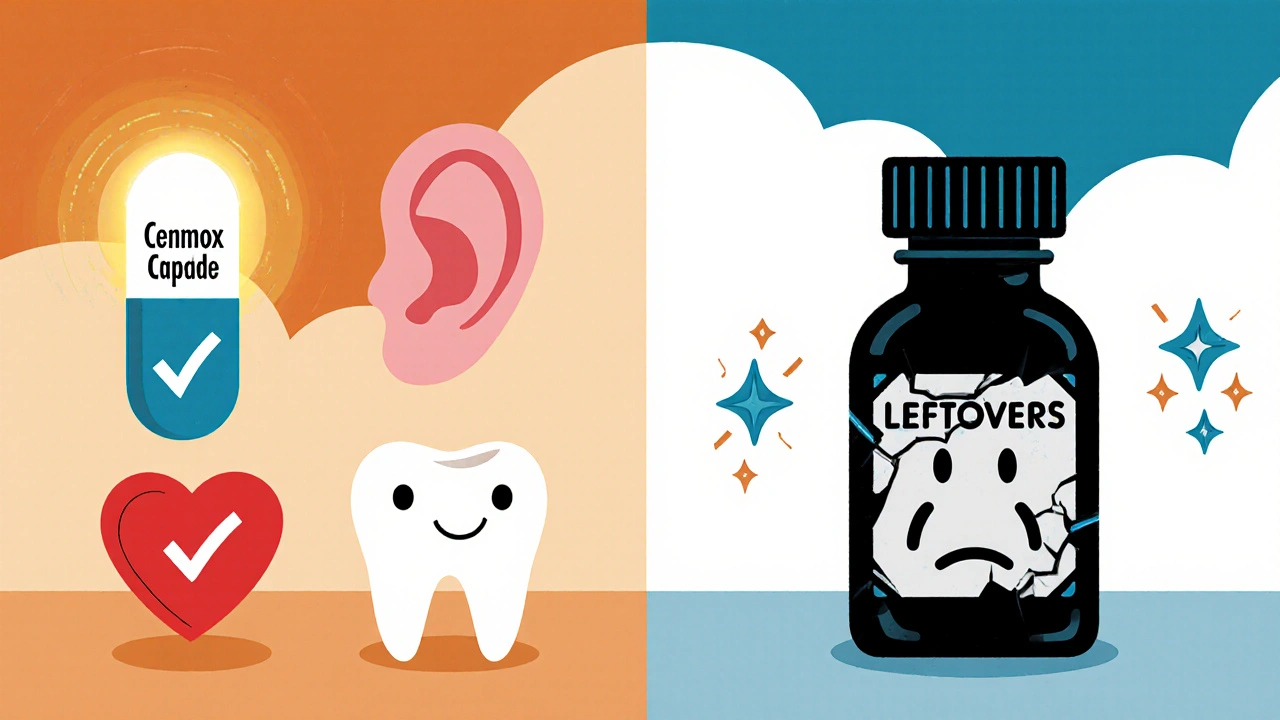Cenmox is a brand name for amoxicillin, a widely used antibiotic that treats bacterial infections. It’s not a new drug - amoxicillin has been around since the 1970s - but Cenmox remains a common choice in many countries because it’s affordable, effective, and well-tolerated. If you’ve been prescribed Cenmox, you’re probably dealing with something like a sinus infection, strep throat, pneumonia, or a urinary tract infection. But what exactly does it do? And why do doctors reach for it so often?
What Is Cenmox Made Of?
Cenmox contains amoxicillin, which belongs to the penicillin class of antibiotics. It works by stopping bacteria from building their cell walls. Without a strong wall, the bacteria burst and die. This makes it effective against many common bacteria like Streptococcus pneumoniae, Haemophilus influenzae, and Escherichia coli.
Unlike some antibiotics that only target certain types of bacteria, amoxicillin has a broad spectrum. That means it can handle a wide range of infections - from ear infections in kids to skin infections in adults. It’s often the first-line treatment because it’s safe, works fast, and doesn’t require special monitoring like some stronger antibiotics do.
The medication comes in capsules, tablets, chewable tablets, and liquid suspension. The liquid form is especially common for children. Each dose is measured in milligrams - typical strengths are 250 mg, 500 mg, and 875 mg. Your doctor picks the dose based on your age, weight, and the type of infection.
How Cenmox Treats Common Infections
If you’ve ever had a sore throat that didn’t go away after a few days, you might have had strep throat. That’s caused by Group A Streptococcus bacteria. A rapid test can confirm it, and if it’s positive, Cenmox is usually the go-to treatment. Most people start feeling better within 48 hours, but you still need to finish the full course - usually 7 to 10 days.
For ear infections in children, Cenmox is often the first choice. The American Academy of Pediatrics recommends it for kids over 6 months with moderate to severe symptoms. In adults, it’s commonly used for sinus infections that last more than 10 days or get worse after initial improvement.
Urinary tract infections (UTIs) are another frequent reason for Cenmox prescriptions. While some UTIs respond to simpler antibiotics like nitrofurantoin, Cenmox is used when the infection is more severe or when the bacteria are known to be sensitive to amoxicillin. In hospitals, it’s sometimes combined with clavulanic acid (as amoxicillin-clavulanate) to fight resistant strains.
Even dental infections - like abscesses or gum infections - often get treated with Cenmox. Dentists rely on it because it reaches high levels in gum tissue and jawbone, helping clear out the infection before it spreads.
Who Shouldn’t Take Cenmox?
Not everyone can take Cenmox. If you’ve ever had a serious allergic reaction to penicillin - like swelling of the face, trouble breathing, or hives - you should avoid it. About 10% of people report penicillin allergies, but many of those aren’t true allergies. If you’re unsure, talk to your doctor. A simple skin test can confirm whether you’re truly allergic.
People with kidney disease may need a lower dose. Cenmox is cleared from the body through the kidneys, so if they’re not working well, the drug can build up and cause side effects. Your doctor will adjust the dose or spacing between doses if needed.
Also, Cenmox can reduce the effectiveness of birth control pills. If you’re using hormonal contraception, use a backup method like condoms during treatment and for a week after. It’s not a guarantee, but it’s a smart precaution.
Some people think antibiotics like Cenmox can treat colds or flu. They can’t. Those are caused by viruses. Taking antibiotics when you don’t need them doesn’t help - it just increases your risk of side effects and contributes to antibiotic resistance. That’s why doctors are more careful now about prescribing them.

Side Effects and What to Watch For
Most people tolerate Cenmox well. The most common side effects are mild: nausea, diarrhea, vomiting, or a mild rash. Diarrhea is especially common - it’s often just a change in gut bacteria and goes away after stopping the medication. Probiotics can help, but they’re not required.
A more serious but rare side effect is Clostridioides difficile (C. diff) infection. This happens when the antibiotic wipes out good bacteria in your gut, letting harmful ones take over. Symptoms include watery diarrhea, fever, and stomach cramps. If you develop these after starting Cenmox, stop taking it and call your doctor right away.
Some people develop a non-allergic rash - usually pink, flat spots - a few days into treatment. This is more common in people with mononucleosis, even if they’re not allergic to penicillin. If you’re unsure whether a rash is an allergy or just a reaction, don’t assume. Get it checked.
Very rarely, Cenmox can cause liver problems or low blood cell counts. These are extremely uncommon, but if you notice yellowing skin, unusual bruising, or extreme fatigue, seek medical help.
How to Take Cenmox Correctly
Take Cenmox exactly as prescribed. Don’t skip doses, even if you feel better. Stopping early can leave behind the toughest bacteria, which then multiply and become resistant. That’s how superbugs form.
You can take it with or without food. Some people find it easier on the stomach if taken with a meal, but it’s not required. If you’re using the liquid form, shake the bottle well before each dose. Use the measuring spoon or syringe that comes with it - kitchen spoons aren’t accurate enough.
Don’t save leftover Cenmox for next time. Antibiotics degrade over time, and using old ones can be ineffective or even dangerous. Dispose of unused medication properly - many pharmacies offer take-back programs.
If you miss a dose, take it as soon as you remember. But if it’s almost time for the next one, skip the missed dose. Never double up to make up for it.
How Cenmox Compares to Other Antibiotics
Many people wonder how Cenmox stacks up against other antibiotics like ampicillin, azithromycin, or doxycycline. Here’s a quick comparison:
| Antibiotic | Class | Best For | Common Side Effects | Take With Food? |
|---|---|---|---|---|
| Cenmox (amoxicillin) | Penicillin | Ear, sinus, throat, UTI, dental infections | Diarrhea, nausea, rash | No |
| Azithromycin (Zithromax) | Macrolide | Respiratory infections, STIs like chlamydia | Stomach upset, dizziness | Yes, on empty stomach |
| Doxycycline | Tetracycline | Lyme disease, acne, some pneumonia | Sun sensitivity, upset stomach | Yes, with water |
| Cephalexin (Keflex) | Cephalosporin | Skin infections, bone infections | Diarrhea, vomiting | No |
Cenmox is usually preferred for kids and pregnant women because it’s been studied extensively and is considered safe. Azithromycin is often used when someone is allergic to penicillin, but it’s more expensive and can cause more stomach issues. Doxycycline isn’t used in children under 8 because it can stain developing teeth.

Why Cenmox Is Still a Go-To After 50 Years
Despite newer antibiotics hitting the market, Cenmox hasn’t been replaced. Why? Because it still works - and it works well. Studies show that for common infections like strep throat and acute otitis media, amoxicillin has a success rate above 85% when taken correctly.
It’s also cheap. In Australia, a 10-day course of Cenmox costs less than $10 with a prescription. That makes it accessible even in rural areas. In places like Darwin, where access to specialists can be limited, having a reliable, low-cost antibiotic matters.
Doctors trust it because they’ve seen it work for decades. It’s not flashy, but it’s dependable. And in a world where antibiotic resistance is growing, keeping effective, narrow-spectrum options like Cenmox in use is critical.
What Happens If Cenmox Doesn’t Work?
If you’ve taken Cenmox for 3-4 days and your symptoms haven’t improved - or if they’ve gotten worse - it’s time to call your doctor. The infection might be caused by a resistant strain of bacteria, or it might not be bacterial at all.
In some cases, your doctor may switch you to amoxicillin-clavulanate (Augmentin), which includes an extra ingredient that blocks bacterial enzymes that resist amoxicillin. Or they might try a different class of antibiotic entirely.
Don’t try to fix it yourself by doubling the dose or taking someone else’s leftover antibiotics. That can make things worse and increase your risk of side effects or resistance.
Can I take Cenmox if I’m pregnant?
Yes, Cenmox is considered safe during pregnancy. It’s classified as Category B by the FDA, meaning animal studies show no risk and human studies haven’t found harm. Many doctors prescribe it for pregnant women with urinary tract infections or strep throat. Always tell your doctor you’re pregnant before starting any medication.
Is Cenmox the same as amoxicillin?
Yes. Cenmox is a brand name for amoxicillin. The active ingredient is identical. Generic amoxicillin works the same way and costs less. The only differences are the manufacturer, packaging, and price. Your pharmacist can help you choose between brand and generic.
How long does Cenmox stay in your system?
Cenmox is eliminated from your body within 6 to 8 hours after taking a dose. That’s why it’s usually taken every 8 or 12 hours. But even though it clears quickly, it keeps working for hours after each dose. You don’t need to take it constantly - just follow the schedule your doctor gives you.
Can I drink alcohol while taking Cenmox?
Yes, alcohol doesn’t interact dangerously with Cenmox. Unlike some antibiotics like metronidazole, it won’t cause severe reactions. But drinking alcohol while sick can weaken your immune system and make recovery slower. It’s better to avoid it until you’re fully recovered.
Can Cenmox cause yeast infections?
Yes, especially in women. Antibiotics like Cenmox can disrupt the natural balance of bacteria in the vagina, allowing yeast to overgrow. Symptoms include itching, burning, and thick white discharge. Over-the-counter antifungal treatments usually help. If it happens often, talk to your doctor about probiotics or preventive options.
Final Thoughts: Use Cenmox Wisely
Cenmox is one of the most trusted antibiotics in the world. It’s simple, effective, and has saved countless lives since it was introduced. But it’s not a magic pill. It only works on bacterial infections - not viruses. It’s not harmless - side effects happen, and misuse leads to resistance.
If you’ve been prescribed Cenmox, take it exactly as directed. Finish the full course. Don’t share it. Don’t save it. And if something doesn’t feel right, call your doctor. Your body deserves careful treatment - and so does the future of antibiotics.



Sameer Tawde
18 November / 2025Cenmox saved my kid’s ear infection last winter. Liquid form, shook it well, finished the whole bottle - no drama. Doctors know what they’re doing.